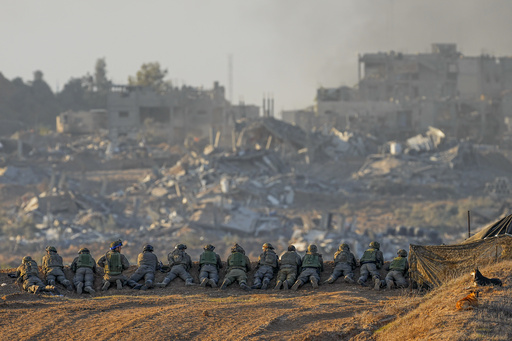
Israel’s ongoing conflict with Hamas and Hezbollah has not only resulted in significant human suffering and loss of life but has also led to a sharp increase in military expenditures, raising concerns about potential long-term impacts on the nation’s economy. The conflict is creating fiscal pressures that could prompt declines in investment and increased taxation, as the government wrestles with budget allocations between military needs and social services.
The Israeli government’s military budget has surged dramatically since the onset of hostilities. Prior to the Hamas attacks on October 7, 2023, military spending was approximately $1.8 billion monthly but soared to around $4.7 billion by the close of last year, according to figures from the Stockholm International Peace Research Institute. For the same period, total military expenditures reached $27.5 billion, positioning Israel 15th in global military spending, ranking just behind Poland, but ahead of countries like Canada and Spain, despite their larger populations. Military spending accounted for 5.3% of Israel’s GDP, a higher proportion than that of both the United States (3.4%) and Germany (1.5%), though significantly less than Ukraine’s allocation of 37% of its GDP toward defense amid its war with Russia.
The war has also negatively affected economic growth and labor availability. In the three months following the October attacks, Israel’s economy experienced a 5.6% contraction, the most severe among the 38 countries in the Organization for Economic Cooperation and Development (OECD). While there was an attempt at recovery with a 4% growth rate in early 2024, growth subsequently faltered, recording just a 0.2% increase in the second quarter. The impact has reverberated through Gaza, where widespread displacement has left 90% of the population without stable housing and unemployment rampant. The economic ramifications are felt in the West Bank as well, where a significant number of Palestinian laborers have lost their jobs, exacerbated by Israeli military operations and movement restrictions. The World Bank noted a staggering 25% contraction in the West Bank economy in the first quarter of the conflict.
The war has imposed numerous economic challenges within Israel. Mobilization for military service has strained the available workforce, while concerns over security have stymied new investments. The tourism sector has also taken a hit due to flight disruptions. Additionally, the government has been compelled to allocate funds for housing displaced individuals from southern regions affected by fighting with Hamas and from northern areas vulnerable to Hezbollah attacks.
Of significant concern is the protracted nature of the conflict, which has persisted for over a year. Comparatively, Israel’s economy bounced back swiftly from a brief engagement with Hezbollah in 2006, which lasted just 34 days. A recent downgrade by Moody’s Ratings on September 27 reflected this ongoing uncertainty, as the agency lowered Israel’s credit rating by two notches. The current Baa1 rating remains within the investment-grade category but indicates moderate risk.
Despite these challenges, Israel’s economy is not on the brink of collapse. The country maintains a diverse and advanced economy bolstered by a robust technology sector, which supports tax revenues and defense budgets. Current unemployment rates are low, and the TA-35 stock index has increased by 10.5% this year. Even amidst conflict, technology firms have managed to secure about $2.5 billion in funding during the third quarter, according to economic experts. When the war began, Israel’s government debt was at a relatively manageable 60% of GDP, a figure that has now risen to 62%, but still fares better than debt levels in countries like France (111%) and comparable to Germany (63.5%). Analysts predict that unless hostilities escalate markedly, debt could reach 80% of GDP by next year while still allowing for necessary defense spending, particularly if a military presence in Gaza is sustained post-conflict.
Finance Minister Bezalel Smotrich has proposed a budget for 2025 that anticipates a deficit below 4%, aiming to stabilize the country’s debt situation. Smotrich has highlighted the resilience of the shekel, increasing share prices, a favorable job market, strong tax revenues, and access to credit as positives for the economy. However, Moody’s has expressed skepticism about these deficit estimates, forecasting a 6% deficit for the upcoming year. The recent downgrade may lead to elevated borrowing costs, which could prompt cuts to public services and raise taxes, according to former Bank of Israel governor Karnit Flug.
Ahead of the conflict, American military aid was approximately $3.8 billion annually under an agreement established during President Obama’s tenure, which constituted around 14% of Israel’s prewar military expenditure, largely benefiting U.S. defense contractors. Following the eruption of hostilities, the U.S. has escalated its military assistance, totaling at least $17.9 billion, as noted by research from Brown University’s Costs of War project. The U.S. has historically provided financial support during crises; Congress approved $9 billion in credit guarantees in 2003 to help stabilize Israel’s economy amid turmoil during the second intifada. Some of these guarantees could potentially be utilized again to avert unsustainable borrowing costs.
In response to these pressing issues, the Israeli government has formed a commission led by former national security adviser Jacob Nagel to assess future defense budget needs and the subsequent economic implications of increased military expenditure. Economists suggest that a financial plan incorporating tax increases and reductions in social services may be necessary to facilitate a rebound and cover anticipated higher defense costs in the post-conflict landscape.
